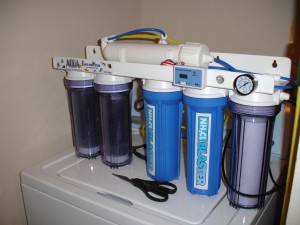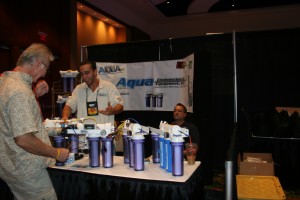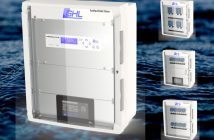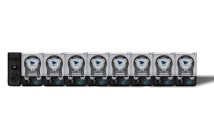Selecting aquarium equipment can sometimes be a stressful task. You don’t know exactly what products you will need or what brands to stay away from. Other times you may not know what features to look for and which ones are total overkill for your setup. This holds especially true for reverse osmosis systems. RO units, as they are abbreviated, come in a huge variety of flavors. Some are complete bare-bones setups, while others have pre-filters, deionization cartridges, and even their own pumps. So how does one go about selecting the number of stages their filter should have, what brands to avoid, or what items are crucial to providing pure water in the long term?
Basic Anatomy
All reverse osmosis units come with one thing, a RO membrane. The membranes come in a couple variations, but that’s beyond the scope of this article. The basic point here is if the filter doesn’t have a RO membrane, it’s not an RO unit. Brilliant deduction, huh? All kidding aside, there are many types of tap water filtration systems available to aquarium hobbyists, and none of them are as effective as a reverse osmosis unit. The membrane does a spectacular job of removing dissolved solids from the water. Chemicals can be added to tap water to make it “safe”, but who really is willing to take that risk? Municipalities are always adding things like chlorine, chloramine, and other nasty compounds to the tap water that most additives aren’t capable of handling. The RO unit is able to handle most of these compounds, given you have the proper filters, providing pure water to your aquarium.
The RO membrane, for obvious reasons, is the most important aspect of the filtration system. Since it can get clogged easily and replacements aren’t cheap, the membrane needs pre-filters to both protect it and extend its useful life. This protection comes in the form of various sediment filters and carbon blocks. They trap larger particles and absorb chemicals, such as chlorine, that can clog or even degrade your membrane. The selection of the appropriate filters can be confusing (see the explanations of each type of pre-filter below), since each one serves a different purpose. But in general, your RO unit should have both sediment and carbon pre-filters. They won’t last as long as the RO membrane, but they are also relatively inexpensive and can really save you some money in the long run.

Clean, new sediment cartridge on the left, compared with cartridge after 8 months (approx. 1500 gallons) on the right.
Pre-filter Types
Pre-filter selection can be quite tricky. There are multiple different types of filters, with each type having its own subset to choose from. The first filter most RO units possess is a sediment filter. The biggest issue with selecting from these is which size to get. Some sediment filters will remove anything larger 5 microns, while others go all the way down to half of a micron. The smaller the microns, the more sediment the filter will trap. Keep in mind though that this also means it will become clogged more easily. There’s really no right or wrong choice. One size might filter more thoroughly while another might last quite a bit longer.
The next type of filter usually encountered contains carbon. In general, carbon will remove chlorine (harmful to the RO membrane), VOCs (volatile organic compounds), and other water contaminants, making it extremely important to the water purification process. The downside though is municipalities have started adding chloramine to tap water, which is a molecule consisting of both chlorine and ammonia. The standard carbon filter cannot effectively handle this, so some RO unit manufacturers will offer a different type of carbon, called activated catalytic carbon. This type of carbon has a positive charge added to it, making it more effective at removing chemicals and impurities.
Post-Membrane Filtration
After the water has gone through the pre-filters and the membrane, it’s still not 100% pure. It may have a low level of total dissolved solids, which is still enough to promote algae growth in your aquarium. This is where the deionization (or DI) resin comes into play. Most RO units come with either a single or dual-chamber DI filter, which as its name suggests removes ions from the water. These ions are not captured by the pre-filters or the membrane, and must be removed somehow. The DI resin binds ions and minerals, effectively removing them from the water. The resin will not remove uncharged organic molecules, which is fine because those are handled in the pre-filter and RO membrane. After the DI stage, the tap one contaminated tap water should be clean of impurities and ready for some salt.
Warning: Do not drink water that has been deionized. It can make you sick. If you would like to drink purified water, make sure to take the water after the membrane, but before it gets to the DI resin.
Useful Accessories
Now that the filters have been discussed, we’ll move on to RO unit accessories. The best accessories for your reverse osmosis filtration system are the TDS meter, which measures total dissolved solids, and a pressure gauge. Both of these will tell you how effectively your system is working. The TDS output will increase as the filters age and become clogged. The system’s pressure will decrease as pre-filters also become coated with junk in the tap water. If you have very low pressure in your system, a pressure boosting pump will also be quite helpful. Not only will it allow your RO unit to better filter contaminates, it will also help you reduce the amount of waste water produced.
Pointless Accessories
Many aquarium keepers are gadget-crazy, requiring their equipment to not only be top of the line, but also have features that aren’t necessary. The average hobbyist doesn’t need to have a reverse osmosis unit capable of pumping out 300 gallons per day (gpd), or one with half a dozen stages (or individual filters). Most can get by on a simple 4-stage unit. While it is nice to have a system capable of solving all of California’s irrigation needs, it’s really not necessary. You will end up paying through the nose to replace all of the filters and membranes, so it’s not really cost effective for the casual hobbyist. Also avoid horizontally placed DI chambers. These are used to save space, but aren’t as effective as a vertically standing DI canister. Because water is traveling from the bottom of a vertically standing filter, it will come into contact with more of the resin thus making it cleaner.
I hope this article makes purchasing an RO unit a little easier. Be sure to avoid units that have odd sized or proprietary filters as they are very expensive to replace and can only be bought from one source. If you can’t find a manufacturer you like, you can build a unit yourself. Separate parts are available all over the web and you can customize it to fit your aquarium’s needs.







